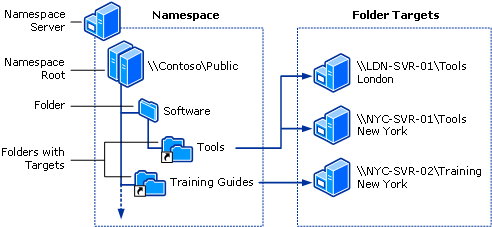Poznámka:
Přístup k této stránce vyžaduje autorizaci. Můžete se zkusit přihlásit nebo změnit adresáře.
Přístup k této stránce vyžaduje autorizaci. Můžete zkusit změnit adresáře.
Obory názvů DFS (Distributed File System) je služba role ve Windows Serveru, která umožňuje seskupit sdílené složky umístěné na různých serverech do jednoho nebo více logicky strukturovaných oborů názvů. To umožňuje uživatelům poskytnout virtuální zobrazení sdílených složek, kde jedna cesta vede k souborům umístěným na více serverech, jak je znázorněno na následujícím obrázku:

Tady je popis prvků, které tvoří obor názvů DFS:
- Server oboru názvů – Server oboru názvů je hostitelem oboru názvů. Server jmenného prostoru může být členský server nebo řadič domény.
- Kořen oboru názvů – kořen oboru názvů je výchozím bodem oboru názvů. Na předchozím obrázku je název kořene veřejný a cesta k prostoru názvů je \\Contoso\Public. Tento typ oboru názvů je obor názvů založený na doméně, protože začíná názvem domény a jeho metadata jsou uložena ve službě Active Directory Domain Services (AD DS). Přestože se na předchozím obrázku zobrazuje jeden server oboru názvů, obor názvů založený na doméně je možné hostovat na více serverech oboru názvů, aby se zvýšila dostupnost oboru názvů.
- Složka – Složky bez cílů složek přidávají do oboru názvů strukturu a hierarchii a složky s cíli složek poskytují uživatelům skutečný obsah. Když uživatelé procházejí složku, která má cíle složky v oboru názvů, klientský počítač obdrží odkaz, který jej transparentně přesměruje na jeden z těchto cílů.
- Cíle složky – Cíl složky je cesta UNC sdílené složky nebo jiného oboru názvů přidruženého ke složce v oboru názvů. Cíl složky je místo, kde jsou uložena data a obsah. Na předchozím obrázku má složka s názvem Nástroje dva cíle složky, jeden v Londýně a jeden v New Yorku a složka s názvem Školicí příručky má v New Yorku jeden cíl složky. Uživatel, který přejde na \\Contoso\Public\Software\Tools, je transparentně přesměrován do sdílené složky \\LDN-SVR-01\Tools nebo \\NYC-SVR-01\Tools v závislosti na tom, ve které lokalitě se uživatel právě nachází.
Tento článek popisuje, jak nainstalovat SYSTÉM SOUBORŮ DFS, co je nového a kde najít informace o vyhodnocení a nasazení.
Obory názvů můžete spravovat pomocí správy DFS, rutin oboru názvů DFS (DFSN) ve Windows PowerShellu, příkazu DfsUtil nebo skriptů, které volají rozhraní WMI (Windows Management Instrumentation).
Požadavky a omezení serveru
Neexistují žádné požadavky na hardware nebo software pro spouštění správy DFS nebo používání DFS Namespaces.
Server oboru názvů je řadič domény nebo členský server, který je hostitelem oboru názvů. Počet oborů názvů, které můžete hostovat na serveru, určuje operační systém spuštěný na serveru oboru názvů.
Servery, na kterých běží alespoň Windows Server 2012, můžou kromě jednoho samostatného oboru názvů hostovat více oborů názvů založených na doméně.
Následující tabulka popisuje další faktory, které je potřeba zvážit při výběru serverů pro hostování oboru názvů.
| Server Hosting Stand-Alone – obory názvů | Server Hosting Domain-Based – obory názvů |
|---|---|
| Musí obsahovat svazek NTFS pro hostování jmenného prostoru. | Musí obsahovat svazek NTFS pro hostování jmenného prostoru. |
| Může to být členský server nebo řadič domény. | Musí být členský server nebo řadič domény v doméně, ve které je obor názvů nakonfigurovaný. (Tento požadavek platí pro každý server oboru názvů, který je hostitelem daného oboru názvů založeného na doméně.) |
| Je možné hostovat clusterem s podporou převzetí služeb při selhání, aby se zvýšila dostupnost oboru názvů. | Namespace nemůže být clusterovaný prostředek v převzetí služeb při selhání clusteru. Jmenný prostor můžete vyhledat na serveru, který zároveň funguje jako uzel v clusteru pro převzetí služeb při selhání, pokud nakonfigurujete jmenný prostor tak, aby používal pouze místní prostředky na serveru. |
Instalace oborů názvů DFS
Oblasti názvů DFS a replikace DFS jsou součástí role Služby souborů a úložiště. Nástroje pro správu systému souborů DFS (Správa DFS, modul Obory názvů DFS pro Windows PowerShell a nástroje příkazového řádku) se instalují samostatně jako součást nástrojů pro vzdálenou správu serveru.
Nainstalujte obory názvů DFS pomocí Windows Admin Center, Správce serveru nebo PowerShellu, jak je popsáno v dalších částech.
Otevřete Správce serveru, klikněte na Spravovat a potom klikněte na Přidat role a funkce. Zobrazí se Průvodce přidáním rolí a funkcí.
Na stránce Výběr serveru vyberte server nebo virtuální pevný disk (VHD) offline virtuálního počítače, na který chcete nainstalovat SYSTÉM SOUBORŮ DFS.
Vyberte služby a funkce rolí, které chcete nainstalovat.
Chcete-li nainstalovat službu Obory názvů DFS, na stránce Role serveru vyberte Obory názvů DFS.
Chcete-li nainstalovat pouze nástroje pro správu systému souborů DFS, na stránce Funkce rozbalte nástroje pro vzdálenou správu serveru, Nástroje pro správu rolí, rozbalte Nástroje souborových služeb a pak vyberte Nástroje pro správu systému souborů DFS.
Nástroje pro správu DFS nainstalují nástroj Snap-in Správa DFS, modul Obory názvů DFS pro Windows PowerShell a nástroje příkazového řádku, ale nenainstalují na server žádné služby DFS.
Interoperabilita s virtuálními počítači Azure
Použití DFS Namespaces na virtuálním počítači v Microsoft Azure bylo testováno.
- Obory názvů založené na doméně můžete hostovat ve virtuálních počítačích Azure, včetně prostředí s ID Microsoft Entra.
- Samostatné obory názvů můžete clusterovat na virtuálních počítačích Azure pomocí clusterů s podporou převzetí služeb při selhání, které používají sdílené disky nebo disky Úrovně Ultra.
Další informace o tom, jak začít s virtuálními počítači Azure, najdete v dokumentaci k virtuálním počítačům Azure.